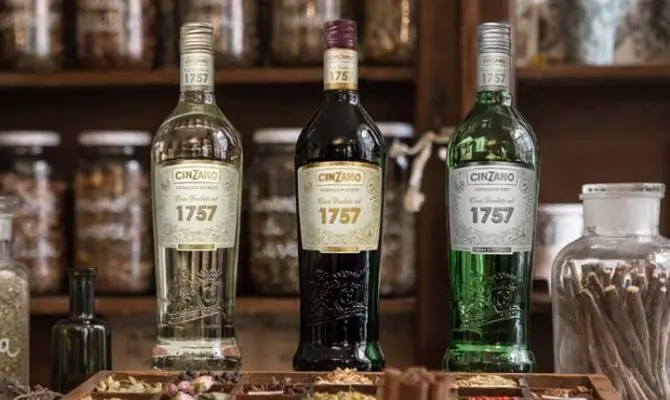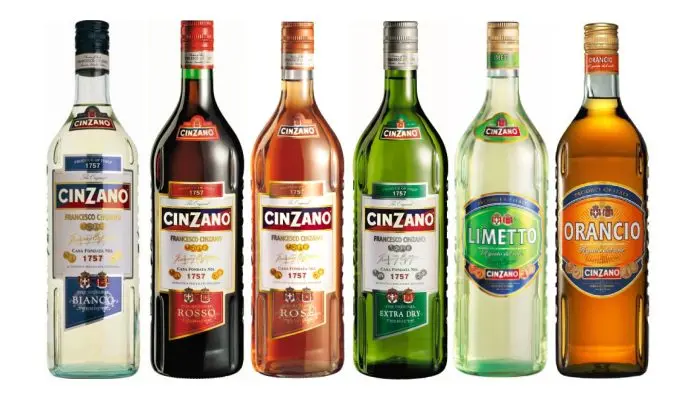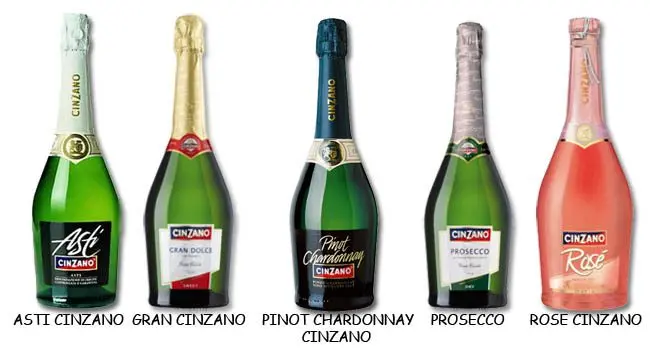Cinzano is an Italian vermouth competitor to Martini. Both brands share the European market almost equally, offering an almost identical range of products.
History. On June 6, 1757, the Cinzano brothers (Giovanni Giacomo and Carlo Stefano) received the title of distillers. Freshly minted specialists opened a small shop in their native Turin and began selling unique aromatic wines made using a secret technology using local herbs, spices and wine drinks.
The popularity of the brand grew, in 1840 the Duke of Savoy turned to the owners of the production with a request to create a wine that could compete with French champagne. So there was the first sparkling wine Cinzano.
Until 1853, modest handmade labels were glued to the bottles, but then they were replaced by bright and eye-catching labels. At the same time, images of the awards won by the drink began to be printed on the bottles. Cinzano was one of the first companies to rely on active advertising – already in 1887, advertisements appeared in Italian newspapers, and in 1889 colorful posters supplemented the text.

The First World War did not interfere with the development of the brand, in 1925 a new logo was introduced. The red symbolized passion and pride, and the blue symbolized nobility, loyalty to tradition and the Mediterranean Sea. As conceived by the designer, the combination of these colors embodies the quintessence of the Italian spirit, and the separating diagonal line is a symbol of the company’s success.
The period from 1929 until the end of the Second World War was not the easiest for the brand, there was intense competition with martinis and other vermouth producers, but Cinzano’s leadership did not lose heart. In the 1960s, the company’s marketers created a number of memorable film and television commercials. One of the first options is presented in the video. Now this advertising seems primitive, but 50 years ago it served its function perfectly.
Italian short toast “chin-chin!” (an analogue of the English “chirz” or the German “prosit”) appeared precisely thanks to one of these advertisements: the actress clinked a glass of Cinzano vermouth, coquettishly uttering this very phrase.
The brand is generally known for its creative and innovative approach to promotion and marketing. In the 1970s, the company released a series of funny and provocative TV commercials designed for a youth audience and are still considered masterpieces of advertising cinematography.
In 1999, the company was taken over by the Campari concern, giving the brand a new modern sound, and 18 years later, Cinzano celebrated its 260th anniversary.
Views of Cinzano
Classic
Cinzano Bianco. Aromatic, full-bodied and delicate. The manufacturer describes him as “friendly, flirtatious and stylish.” Refreshing notes of herbs and spices are felt in the bouquet: cinnamon, nutmeg, etc. Vermouth is served chilled, ice cubes are added to the glass. Bianco is drunk in its pure form, but if desired, it can be diluted with lemonade, grapefruit juice, soda (carbonated mineral water) in any proportion. Fortress – 15%.
Cinzano Rosso. A dark red vermouth with an “exciting, rich and daring” taste. The bouquet has velvety vanilla, floral tones, red berries, caramel. This drink is also drunk chilled and in its pure form, but Rosso goes well with apple juice (especially if you add a cinnamon stick to the cocktail). The alcohol content is 14,8%.
Cinzano Extra Dry (Cinzano Extra Dry). Light vermouth, taste – “careless and tempting” with a slight bitterness. Most often it acts as a base for classic cocktails, it is ideal with gin or vodka, but can also be mixed with soft drinks. Fortress – 14,8%.

All three classic looks have a collector’s edition “1757”, released in honor of the founders of the brand. These vermouths are distinguished by decorative gift packaging, a more pronounced and bright taste.
flavored wine
Orancio. Fortress – 14,4%. Orange vermouth, served with ice, both in pure form and with mineral water or Sprite.
Rose (14,8%). Pink vermouth with tones of orange, cinnamon, vanilla, cloves. Served in the same way as Orancio.
Limetto (14,4%). Lime-based drink, most often used as an aperitif.

Champagne Cinzano
Pinot Chardonnay. Sparkling brut, made from Pinot and Chardonnay grapes. Distinguished by a delicate fruity aroma, served before dinner or with light snacks. Combines with seafood, vegetable soups, risotto, white meat.
Gransec. Dry sparkling wine. It has a balanced fruity taste, served on special occasions as an aperitif, served in glasses. Makes good gastronomic pairs with grilled vegetables, pumpkin, cold cuts, parmesan, salmon, carpaccio and other delicate snacks.
Cinzano Prosecco DOC Dry aromatic wine from the best appellations of Northern Italy. The taste of fresh apples is clearly felt, this champagne is usually served with light snacks, ice cubes are added to the glass, you can mix Prosecco with Cinzano Limetto.
Rose. Pink champagne with subtle nuances of strawberry and raspberry. Ideal for special occasions, dinners for two, romantic evenings by the sea or lake. Served well chilled, combined with a fish plate, shrimp, walnuts, cheesecake, couscous.
Gran Dolce. Semi-sweet white sparkling wine made from berries from the best Italian vineyards. It has a fresh, balanced taste, best paired with desserts and fresh fruit.
Asti DOCG (Cinzano Asti). Perhaps the most famous champagne of the Cinzano line. Produced exclusively from white nutmeg berries from the Asti region. In the bouquet of sparkling wine, delicate notes of honey, ripe peaches, acacia flowers are felt. It is drunk in its pure form from wine glasses.

Cinzano’s awards from Martini
The first thing that distinguishes vermouths is, of course, the recipe, but the exact composition of both drinks is kept secret, so the details are unknown. Italian brands are very similar: they produce vermouths based on aromatic spices and herbs, they have developed a line of sparkling wines, both are popular in Europe and beyond.
However, there are still small differences:
- Cinzano is 100 years older.
- It is believed that Cinzano uses more components (components) in the manufacture of vermouths.
- Martini is slightly more bitter, and in terms of brand perception it is considered a symbol of bohemianism and luxurious living, while Cinzano is “simpler” and “more folk”.









